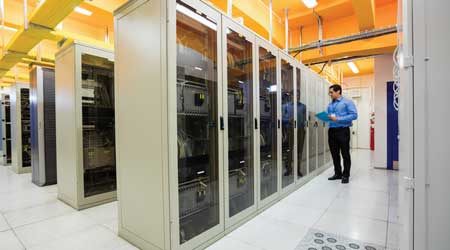 To plan for emergency cooling, managers need to understand the needs of key areas, such as data centers.
To plan for emergency cooling, managers need to understand the needs of key areas, such as data centers.Emergency Cooling: Avoid Specification Mistakes
Ensuring cooling in a crisis requires that managers address facility needs, equipment options and operational issues
One common mistake in selecting the most appropriate cooling unit involves determining needed cooling capacity for the space in question. For each such area, managers need to estimate the size of the portable unit that will be brought in temporarily.
If a unit is too small, it will not meet the area’s cooling needs. If it is too large, it might exceed the capacity of the supporting utility system, operate inefficiently or fail to provide adequate humidity control. And if the system is oversized, it might be physically too large to be located close to the area in question, resulting in siting issues and additional installation costs.
The most accurate way to size a portable unit is for engineers to perform load calculations for the space, taking into account heat gains from exterior walls, windows, people, equipment and surrounding areas.
Calculating cooling loads can be difficult, but a couple of rules of thumb can produce reasonable estimates. One way to estimate an area’s required cooling capacity is by using the cooling capacity of the system that is being temporarily replaced. If it is a one-for-one replacement — meaning the temporary cooling system is to serve all areas served by the failed system — then the temporary system must have the same or slightly larger cooling capacity. If the temporary system needs to cool only a portion of the area served by the failed system, then managers will have to apply rules of thumb or more accurate actual load calculations.
For typical office buildings, the amount of cooling required is 1 ton for every 200-350 square feet of floor space. For computer rooms, 1 ton of cooling is required to serve 50-150 square feet of floor space. In health care facilities, 1 ton of cooling is sufficient for every 250-300 square feet.
If a space has no unusual loads, such as a large area of south-facing windows or heat-producing equipment, the rule of thumb is to provide 1 ton of cooling for every 500 square feet of space. If the space has unusual heat-producing loads, managers can assume the need for 2 tons of cooling per 500 square feet of space.
All of these rule-of-thumb figures are for basic operations under average use, installed heat-producing equipment, average occupancy and average environmental conditions. Managers will have to adjust the square footage of building space per tons of cooling numbers higher or lower based on actual conditions.
Such rules can provide an approximation of cooling load requirements, but managers should use them with extreme caution. Depending on the actual conditions, they might seriously undersize or oversize equipment requirements. The only way to get accurate, reliable numbers for a particular application is to have an engineer calculate the actual heat loads based on the operations performed in a particular space.
Related Topics:














